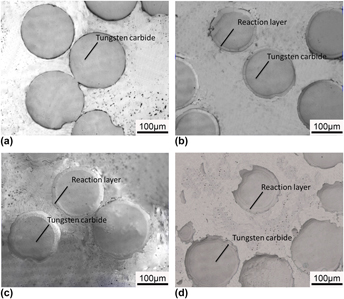Crossref Citations
This article has been cited by the following publications. This list is generated based on data provided by
Crossref.
Sui, Yudong
Han, Lina
Jiang, Yehua
Li, Zulai
and
Shan, Quan
2018.
Effects of Ni60WC25 powder content on the microstructure and wear properties of WCp reinforced surface metal matrix composites.
Transactions of the Indian Institute of Metals,
Vol. 71,
Issue. 10,
p.
2415.
Chen, Feng Rui
Li, Zu Lai
Shan, Quan
Jiang, Ye Hua
Zhang, Ya Feng
and
Zhang, Fei
2018.
Effects of Different Matrix on Interface and Compression Fracture Behavior of WC Particles Reinforced Iron Matrix Composites.
Materials Science Forum,
Vol. 913,
Issue. ,
p.
480.
Li, Zulai
Wang, Pengfei
Shan, Quan
Jiang, Yehua
Wei, He
and
Tan, Jun
2018.
The Particle Shape of WC Governing the Fracture Mechanism of Particle Reinforced Iron Matrix Composites.
Materials,
Vol. 11,
Issue. 6,
p.
984.
Liu, Yangzhen
Fu, Hanguang
Li, Wei
Xing, Jiandong
Li, Yefei
and
Zheng, Baochao
2018.
Mechanical properties and chemical bonding of M2B and M2B0.75C0.25(M = Fe, Cr, W, Mo, Mn) compounds.
Journal of Materials Research,
Vol. 33,
Issue. 22,
p.
3665.
Zhong, Lisheng
Bai, Haiqiang
Wei, Junzhe
Zhu, Jianlei
Peng, Jianhong
Lu, Zhengxin
and
Xu, Yunhua
2019.
In situ fabricated metal-carbide with core–shell structure for high impact-toughness iron-matrix composite.
Materials Science and Technology,
Vol. 35,
Issue. 14,
p.
1727.
Zhang, DongLan
Li, ZuLai
Shan, Quan
Jiang, YeHua
Feng, Jing
and
Chong, XiaoYu
2020.
Thermodynamic analysis of the interface reaction and thermal stress of WCp/Fe composites.
Ceramics International,
Vol. 46,
Issue. 16,
p.
26210.
Wang, Yaowei
Huang, Yiming
Yang, Lijun
and
Sun, Tao
2021.
Microstructure and property of tungsten carbide particulate reinforced wear resistant coating by TIG cladding.
International Journal of Refractory Metals and Hard Materials,
Vol. 100,
Issue. ,
p.
105598.
Zhang, Qiao
Chen, Baojiang
Chen, Zheng
Zhu, Zhixiang
Hu, Xudong
Ding, Yi
and
Liang, Shuhua
2021.
Microstructure and properties of W Cu composites reinforced by in-situ generated WC.
International Journal of Refractory Metals and Hard Materials,
Vol. 99,
Issue. ,
p.
105585.
Fan, Lei
Ou, Peng
Rong, Ju
and
Yu, Xiaohua
2022.
Preparation of high wear resistance nickel based WC coating by carefully adjusting interface structure.
Materials Research Express,
Vol. 9,
Issue. 8,
p.
086402.
Ding, Juan
Zhu, Wentan
Ma, Yunzhu
Liu, Wensheng
Huang, Yufeng
and
Liang, Chaoping
2022.
Evaluation of phase relationship in W-Fe-C ternary system through symmetry principles and first-principles calculation.
Materials & Design,
Vol. 224,
Issue. ,
p.
111376.
Shengbin, Zhao
Chenpeng, Jia
Yuxue, Yuan
Lixin, Wang
Yiming, Huang
and
Lijun, Yang
2022.
Effects of laser remelting on microstructural characteristics of Ni-WC composite coatings produced by laser hot wire cladding.
Journal of Alloys and Compounds,
Vol. 908,
Issue. ,
p.
164612.
Zhao, Shengbin
Xu, Sai
Yang, Lijun
and
Huang, Yiming
2022.
WC-Fe metal-matrix composite coatings fabricated by laser wire cladding.
Journal of Materials Processing Technology,
Vol. 301,
Issue. ,
p.
117438.
Zhao, Shengbin
Jia, Chenpeng
Yuan, Yuxue
Wang, Lixin
Huang, Yiming
and
Yang, Lijun
2022.
Insights into microstructural evolution and dissolution characteristics of reinforced particles in tungsten carbide‑nickel composite coatings prepared by laser hot-wire deposition.
International Journal of Refractory Metals and Hard Materials,
Vol. 103,
Issue. ,
p.
105720.
Shabalin, Igor L.
2022.
Ultra-High Temperature Materials IV.
p.
11.
Zhang, Wengao
Li, Zulai
Wei, He
Xiang, XinHua
Zhang, Fei
and
Shan, Quan
2022.
Interfacial structure of WC-Fe metal-matrix composite (WC/Fe3W3C and Fe/Fe3W3C) stability, electronic and mechanical properties from first-principles calculations.
Materials Today Communications,
Vol. 33,
Issue. ,
p.
104470.
Zhang, Fei
Gou, Haojie
Zhang, Wengao
Huang, Qinyuan
Li, Zulai
Wei, He
Chong, Xiaoyu
Sui, Yudong
Wu, Xing
and
Shan, Quan
2023.
Interface microstructure and abrasive wear properties of WC-iron matrix composites with Ni, Mo, Fe added to the preforms.
Journal of Materials Research and Technology,
Vol. 24,
Issue. ,
p.
4218.
Haag, James V.
Olszta, Matthew J.
Edwards, Danny J.
Jiang, Weilin
and
Setyawan, Wahyu
2023.
Characterization of boundary precipitation in a heavy ion irradiated tungsten heavy alloy under the simulated fusion environment.
Acta Materialia,
p.
119059.
Deng, Chao
Zhong, Lisheng
Wang, Xianhui
Zhu, Jianlei
Peng, Jianhong
and
Hu, Xu
2023.
Origin of the distinction in hardness of lower tungsten carbides: An experimental and ab initio theoretical study.
Journal of the American Ceramic Society,
Vol. 106,
Issue. 3,
p.
2184.
Nana, Zhao
Congcong, Ren
Jiajing, Zhao
Yuting, Wang
Zhen, Cui
and
Lisheng, Zhong
2024.
First-principles study on the interfacial electronic structure and analysis of the bonding properties of NbC/Fe composites.
Materials Today Communications,
Vol. 38,
Issue. ,
p.
107592.
Dong, Wenlong
Yang, Xuefeng
Shen, Shikai
Wang, Kai
and
Liu, Bowen
2024.
WC-18Co reinforced Iron matrix composites: Microstructure and interface characteristics.
Journal of Alloys and Compounds,
Vol. 976,
Issue. ,
p.
173066.






